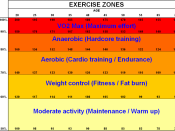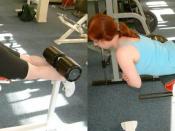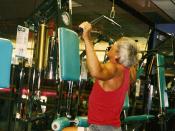* Principles of training
Progressive overload: "no pain, no gain", to produce a training effect exercise should be performed at a level slightly above what usually perform. E.g. progressively increase time till 1 hr then increase intensity as you decrease time.
Specificity: specific training to your specific sport, e.g. strength training increases muscle strength, aerobic training increases endurance capacity
Reversibility: if there is a break in your training your fitness will decline, stop training = loss of fitness, strength etc.
Varity: motivational tool in overcoming boredom, variety keeps you interested and helps psychologically.
GAS (introducing changes) =
Alarm - body stressed, gives signs (â pulse & blood sugar)
Adaptation - alarm stage reversed, body coping
Exhaustion - body breaks down (over training)
Training Thresholds: minimum amount of exercise required to produce an improvement in one or more aspects of your fitness.
Aerobic threshold - 50 - 70% of maximum heart rate
Anaerobic threshold - 60 - 90% of maximum heart rate
Warm up/Cool down: should proceed and end every training session.
It helps to raise body temp, increase blood flow, increase muscle movement warm down reduces risk of injury, blood clotting and stiff muscles.
* Types of training
The purpose of training is to prepare the body for the optimum response to the physical demands of performance. Regular training is beneficial for cardio respiratory system, strength and flexibility
Aerobic Training: oxygen used, HR increased must maintain for 20 mins to have an effect
Strength Training: capacity of the body to exert force through muscle power, increases muscle strength, power and endurance. Contractions used: Isometric (muscles push against but don't lengthen e.g. push up), Isotonic (dynamic contractions, length changes full range of movement e.g. bicep curl) and isokinetic (specialized machines in gym)
Flexibility Training: movement aloud by the...


